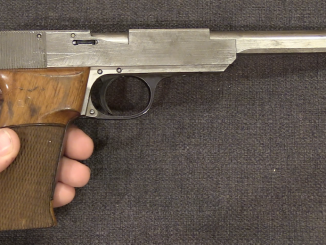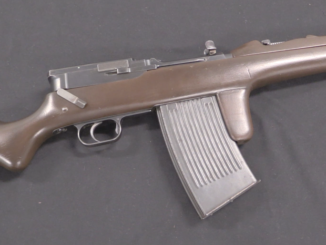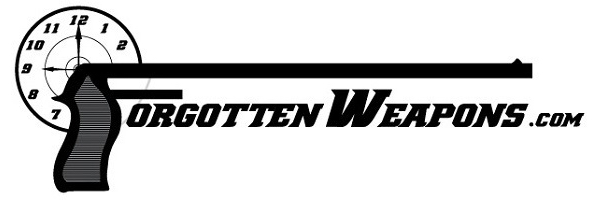This Luger has seen basically all of 20th century German history. It began as a 1917 production DWM pistol, used in World War One. After the war, it was one of the guns remarks for use by the police and military of the Weimar Republic, and at some point in this period had a special police safety installed, to prevent a careless officer from accidentally shooting himself with the disassembled slide assembly. That safety was later removed, and the pistol remained in German official service through World War Two. It was still there when the eastern half of Berlin was occupied by the Soviets, and was issued to the Volkspolizei of Soviet-controlled Weissensee. During this time, it was reissued new matching magazines made by Haenel in East Germany. When the Berlin Wall came down, it was liberated from a Stasi arms depot in Weissensee, and a few years later reproofed under the newly unified Germany to make it legal on the commercial market. Today it resides in the collection of a European arms collector, who found it for sale and recognized the tremendously long history shown in its markings.
Related Articles

Prototype
Toolroom Prototype .32 ACP Walther Olympia
In the late 1930s, Walther experimented with the idea of an Olympia target pistol in .32 ACP. They used the frame from a 1936 pattern standard (.22LR) Olympia with a .32 caliber barrel, increased mass […]

Bolt Action Rifles
Book Review: The K98k Rifle (Propaganda Photo Series Vol. I)
There is an excellent series of books on German WWII small arms being written and published out of the Netherlands – the Propaganda Photo Series. Today I am specifically looking at Volume I, which covers […]

Semiauto Rifles
Mauser WW1 Flyer’s Rifle: the Flieger Selbstlader Karabiner 1916
Paul Mauser dedicated much of his life to the development of a practical semiauto military rifle, and did manage to have a design that was used in combat by Germany in World War One. It […]

AS someone else said, “Lugers forever!!” This is a gun that could last a freakishly long time and still kick butt if well maintained. Heck, even the much vaunted ion blaster rifle would lose in terms of trench reliability. Get a blaster wet and it shorts out. Get a Luger muddy on the outside and its owner retaliates by emptying his magazine into whomever threw mud on him.
Curiously there might be such Parabellum Pistole which would deserve all that flags without leaving Berlin. Testimony of turbulent times.
“AS someone else said, “Lugers forever!!” This is a gun that could last a freakishly long time and still kick butt if well maintained.”
Parabellum Pistole? I would say it is over-hyped. We do not know how exactly it was used – how frequently it was fired? I would not be surprised if for years it was safely conserved and stored, so I would say other automatic pistols of good quality could possibly also serve such long.
That being said Parabellum Pistole should be evaluated high as 19th century automatic pistol (it was adopted in 1900 by Switzerland), but by 1930s standards it was unacceptable expensive to produce, so Germany introduced P.38, Finland (which also at that moment used Parabellum) L-35, even Switzerland, where expensive solutions were often accepted, replaced it with SIG P210 starting in late 1940s (although SIG already tested various prototypes yet during World War II)
In the 2015 Gun Digest, on p. 248 you’ll find an article titled “The 3 Deadliest Gunfighting Pistols of All Time” by Jim Dickson.
In it, he states that
It is also quite reliable when fed the correct ammunition, even in the bloody trench warfare of World War One;
BTW, Dickson’s ratings are based on total combat kills and casualties the weapon has inflicted. As such, his No. 2 was the Colt M1911/M1911A1 in .45 ACP, and rounding out the top 3 was the Colt Model 1873 Single Action Army in .45 Colt and the “Frontier Six Shooter” in .44-40 WCF. Those two “Peacemaker” calibers accounted for roughly 85% of Model Ps ever made by Colt, and also accounted for the majority of men killed or wounded by Peacemakers. The Colt “six shooter” outstrips other lesser handguns simply by virtue of having been in service longer than any other handgun still in common use.
cheers
eon
Fully exposed barrel… quite revealing information. It makes more sense now.
I also wondered why they made that a requirement! Makes sense, now.
I have to admit I don’t completely buy it. The main reason the Parabellum has an exposed barrel is that the Borchardt pistol it was derived from had one. And the Borchardt apparently had one because Hugo Borchardt wanted a self-loading pistol with roughly the same “balance” (weight distribution) as a revolver.
Another thing; one factor in the design of the P.38 pistol was wanting a service pistol that could be fired through a “pistol port” on an AFV. The Russian Army similarly wanted such a service pistol about the same time(hence the Tokarev, Voyevodin and Korovin 1939 designs seen on pp.528-530 of Ezell’s Handguns of the World), but the war intervened.
Also remember that most of the other early autopistol design, such as the Mauser C/96 and the Bergmanns, all had “exposed” barrels. In the beginning, that was apparently just “the way everybody did it”, and maybe no more than that should be read into it.
cheers
eon
That the exposed barrel thing was “the way everybody did it” is probably true UNTIL Browning’s revolutionary barrel-inside-slide became “the way everybody did it”. Germany bought P-35s, Astras and others of Browning’s configuration, so the exposed barrel requirement before adoption of the P-38 remains somewhat a mystery.
“Russian Army similarly wanted such a service pistol about the same time”
Tokarev (1939): https://raigap.livejournal.com/138375.html
Korovin (1939): https://raigap.livejournal.com/256334.html
Rakov (1939): https://raigap.livejournal.com/245261.html
Voyevodin (1939): https://raigap.livejournal.com/242051.html
Mayn-Krekin (1938): https://raigap.livejournal.com/460007.html
all fired 7,62×25 model 1930 cartridge
“based on total combat kills and casualties the weapon has inflicted”
This spawn question how he gathered that data? While fact weapon which was used in bigger quantity is higher look sensible I doubt that for every soldier fallen during Great War weapon which killed can be pointed with 100% sure.
I would say it might be even less accurate, than claimed aerial victories during World War II, however it this case it is possible to verify if victory of one side actually match loss of second side.
“(…)the best pointing pistol ever made, bar none. Just point at the target and you hit it. it is as simple as that. It is also the most accurate pistol you will ever find.”
If it ergonomics is so good, why differently shaped automatic pistols prevailed?
I think these claims are not well backed. Any decent pistol is deemed to have adequate capabilities when comes to aiming. Where Luger stands apart is its radical grip angle (measured relative to horizontal reference plane 55deg from back forward).
But there is not one “best” grip angle. If we look at rather successful Croatian made pistols (sold under name Springfield), their grip angle is modest 75 degree and they still “feel” well. Rarely pistols sport more reclined grip than that.
“But there is not one “best” grip angle. If we look at rather successful Croatian made pistols (sold under name Springfield), their grip angle is modest 75 degree and they still “feel” well. Rarely pistols sport more reclined grip than that.”
Indeed for example Savage Automatic Pistol was advertised as AIMS EASY AS POINTING YOUR FINGER, see 4th image from top here:
https://americanhandgunner.com/savage-model-1907-ten-shots-quick/
Ultimately, feed reliability. Granted, the Parabellum is a good “pointer” (as are quite a few .22 LR target autos with similar grip-to-bore angles) but in spite of all protestations about loads, the Parabellum is an iffy feeder at best.
In my experience, it likes 124-gr. round-nosed FMJs at 1,150-1,200 F/S, and the “eight-shot” magazine works best if you start with only seven rounds in it. In fact, the Mitchell “Lugers”‘ manual stated quite clearly that the magazine, which was in all respects identical to every other P.08 magazine ever made, should only be loaded with seven cartridges for optimum functioning.
Probably the most feed-reliable service autos are those based on John M. Browning’s designs. This includes the Smith & Wesson autos derived from the Model 39 (but not the reprehensible Sigma series), the Colt M1911 family, and of course the P-35 High Power.
On the other hand, the Taurus PT-92/99 series have always been more reliable feeders than the Beretta M92 series they are based on. No, I have no idea why.
cheers
eon
[off topic so ignore if you wish]
You can watch video with Beardmore-Farquhar light machine gun in action here:
https://www.youtube.com/watch?v=dhHlaHqt-48
apparently, it is promotional material, and it prove that doing impressive show is nothing new.
Very obvious that live performance ads are older than television! Try live firing of Maxim guns by nobility and even the Kaiser… everyone experienced firing the guns firsthand and loved it. I could be wrong.
Amazing track record for one odd pistol. It proves that all firearms and weapons in general are basically apolitical and that’s what I like about them. Claims that there are “Nazi” or “communist” firearms are out of place. No such a thing.
Yes, every piece of armament has its maker and temporary user, that’s about it. User can be changed any time.
P08 and the similar Ruger .22 cal. grip angles are not my favorites. In my hand these pistols “naturally” point high and require a conscious effort to bring the muzzle down. For myself this is also true for Colt Woodsman and High Standard pistols.
They might work fine for other shooters. Relatively few pistols with this angle are currently manufactured.
Interestingly during Great War, Austria-Hungary used automatic pistol with also untypical (from today point of view) angle of grip, although in opposite side to Parabellum-Pistole, namely Steyr-Hahn with grip making near to right angle.
Early Ruger Mk 1/2 .22s were advertised as having an “ideal” grip angle, similar to the Luger. Later, Ruger 1911/22s frame was redesigned to incorporate the “ideal” 1911 angle.
Muzzle attitude on a 1911 can be tailored to suit by replacing the MS housing.
BHP, Spfld XD, and CZ 75 et.al. frame shapes possibly provide a more universal fit.
Many new-production pistols offer replaceable backstraps to suit the user, extreme angles once popular are less common nowadays.
Magazine design and cartridge feeding requirements may have dictated on the grip angle of some pistols. But I am not aware of any Colt/Browning designs with such extreme angles as the P08. Indeed, some were nearly vertical.
It may be the muzzle-up cant was intentional, forcing the shooter to torque or preload the pistol to mitigate muzzle rise at recoil.
At any rate, a pencil gripped in my fist at arm’s length is closer to the 1911 angle than that of a P08.
Since the swastika is banned under laws that ban the display of National Socialist symbols, it can be easily sidestepped by using the Avengers Hydra skull as a substitute symbol.